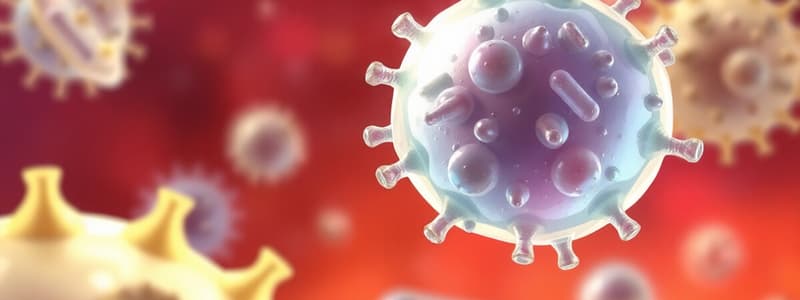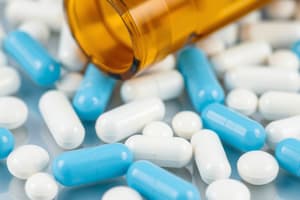Podcast
Questions and Answers
What is the main principle behind the selective toxicity of antibiotics?
What is the main principle behind the selective toxicity of antibiotics?
- Antibiotics target components unique to bacterial cells. (correct)
- Antibiotics are synthesized only in laboratories.
- Antibiotics affect all cells equally.
- Antibiotics are naturally toxic to humans.
Antibiotics can be safely administered to pregnant women and children without any risks.
Antibiotics can be safely administered to pregnant women and children without any risks.
False (B)
What is the term used for the chemical compounds that are synthesized by microbes to selectively kill other microbes?
What is the term used for the chemical compounds that are synthesized by microbes to selectively kill other microbes?
Antibiotics
Antibiotics are selectively toxic to __________ but not to eukaryotic organisms.
Antibiotics are selectively toxic to __________ but not to eukaryotic organisms.
Match the antibiotic with its potential side effect:
Match the antibiotic with its potential side effect:
What does the term 'spectrum of activity' refer to in the context of antibiotics?
What does the term 'spectrum of activity' refer to in the context of antibiotics?
Bactericidal antibiotics are those that prevent the growth of bacteria rather than killing them.
Bactericidal antibiotics are those that prevent the growth of bacteria rather than killing them.
What is defined as the lowest concentration of the drug that will prevent the growth of an organism?
What is defined as the lowest concentration of the drug that will prevent the growth of an organism?
Penicillin is classified as a __________ spectrum antibiotic because it primarily affects Gram-positive bacteria.
Penicillin is classified as a __________ spectrum antibiotic because it primarily affects Gram-positive bacteria.
Match the following antibiotics with their spectrum of activity:
Match the following antibiotics with their spectrum of activity:
What does a higher chemotherapeutic index indicate?
What does a higher chemotherapeutic index indicate?
Synergistic drugs work independently without enhancing each other’s effectiveness.
Synergistic drugs work independently without enhancing each other’s effectiveness.
What is the term used for the minimum dose per kg of body weight necessary to stop pathogen growth?
What is the term used for the minimum dose per kg of body weight necessary to stop pathogen growth?
A combination of a bactericidal agent and a __________ agent usually leads to antagonism.
A combination of a bactericidal agent and a __________ agent usually leads to antagonism.
Which of the following is an example of a synergistic combination?
Which of the following is an example of a synergistic combination?
Toxic dose is defined as the minimum dose tolerated by the patient.
Toxic dose is defined as the minimum dose tolerated by the patient.
List one way to classify antibacterial agents.
List one way to classify antibacterial agents.
N-acetylglucosamine (NAG) and N-acetylmuramic acid (NAM) are linked to form __________ chains in bacterial cell walls.
N-acetylglucosamine (NAG) and N-acetylmuramic acid (NAM) are linked to form __________ chains in bacterial cell walls.
Match each antibiotic type with its primary function:
Match each antibiotic type with its primary function:
What occurs when bacteriostatic agents are combined with bactericidal agents?
What occurs when bacteriostatic agents are combined with bactericidal agents?
Flashcards are hidden until you start studying
Study Notes
Antibiotic Action
- Antibiotics are chemical compounds made by microbes that selectively kill other microbes.
- Many are produced naturally, others are synthesized chemically.
- They exhibit Selective Toxicity, meaning they target bacterial physiology, not human physiology.
- Antibiotics target structures that are different in bacteria compared to eukaryotes like peptidoglycan, ribosomes, and DNA gyrase.
Antibiotic Spectrum of Activity
- Antibiotics are classified by their spectrum of activity, the types of organisms they affect:
- Antibacterial (bacteria)
- Antiprotozoal (single-celled eukaryotes)
- Antiviral (viruses)
- Within antibacterial, antibiotics can have a narrow spectrum (specific bacteria) or a broad spectrum (multiple types of bacteria).
Bactericidal vs. Bacteriostatic Antibiotics
- Antibiotics are also classified as bactericidal (kill bacteria) or bacteriostatic (inhibit bacterial growth).
- Bacteriostatic antibiotics require the host's immune system to clear the infection.
Measuring Antibiotic Effectiveness
- Minimum Inhibitory Concentration (MIC) is the lowest concentration of an antibiotic that prevents bacterial growth.
- MIC is determined by serially diluting an antibiotic and inoculating bacteria into each dilution.
- Chemotherapeutic index is the ratio of the toxic dose to the therapeutic dose.
- A higher chemotherapeutic index indicates a safer drug.
Synergism and Antagonism
- Synergism occurs when two antibiotics used together have a greater effect than the sum of their individual effects.
- Antagonism occurs when two antibiotics interfere with each other, reducing their effectiveness.
Antibacterial Mechanisms of Action - Cell Wall Synthesis Inhibitors
- Beta-lactam antibiotics (e.g., penicillin) inhibit the synthesis of the bacterial cell wall by binding to penicillin-binding proteins (PBPs).
- PBPs are enzymes responsible for cross-linking peptidoglycan, a major component of the bacterial cell wall.
- Beta-lactams structurally resemble peptidoglycan and block PBP activity, leading to weakened cell walls and cell lysis.
Antibacterial Mechanisms of Action - DNA Synthesis Inhibitors
- Metronidazole (Flagyl) is a prodrug activated by anaerobic bacteria.
- It damages DNA by nicking it, leading to cell death.
- Metronidazole is effective against anaerobic bacteria like Bacteroides and Fusobacterium.
- Quinolones (e.g., ciprofloxacin, levofloxacin) inhibit DNA gyrase, an enzyme that unwinds DNA.
- Inhibition of DNA gyrase leads to accumulation of positive supercoils, preventing DNA replication and bacterial growth.
Antibacterial Mechanisms of Action - RNA synthesis Inhibitors
- Rifampin binds to bacterial RNA polymerase, preventing the synthesis of mRNA.
- This inhibits transcription and bacterial growth.
- Rifampin is used to treat tuberculosis and meningococcal meningitis.
Antibacterial Mechanisms of Action - Protein Synthesis Inhibitors
- Protein synthesis inhibitor target bacterial ribosomes and interfere with protein translation, which is essential for bacterial growth.
- These antibiotics are often bacteriostatic, meaning they inhibit growth rather than causing immediate death.
- These inhibitors bind to bacterial rRNA, which differs from eukaryotic rRNA, enabling selective toxicity.
Studying That Suits You
Use AI to generate personalized quizzes and flashcards to suit your learning preferences.




